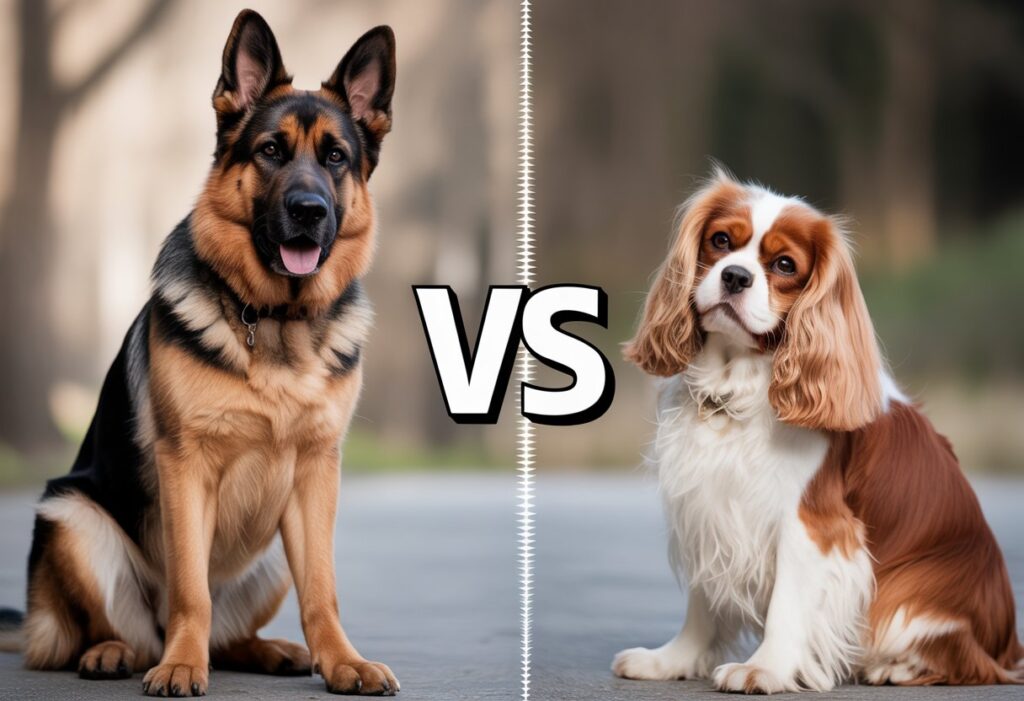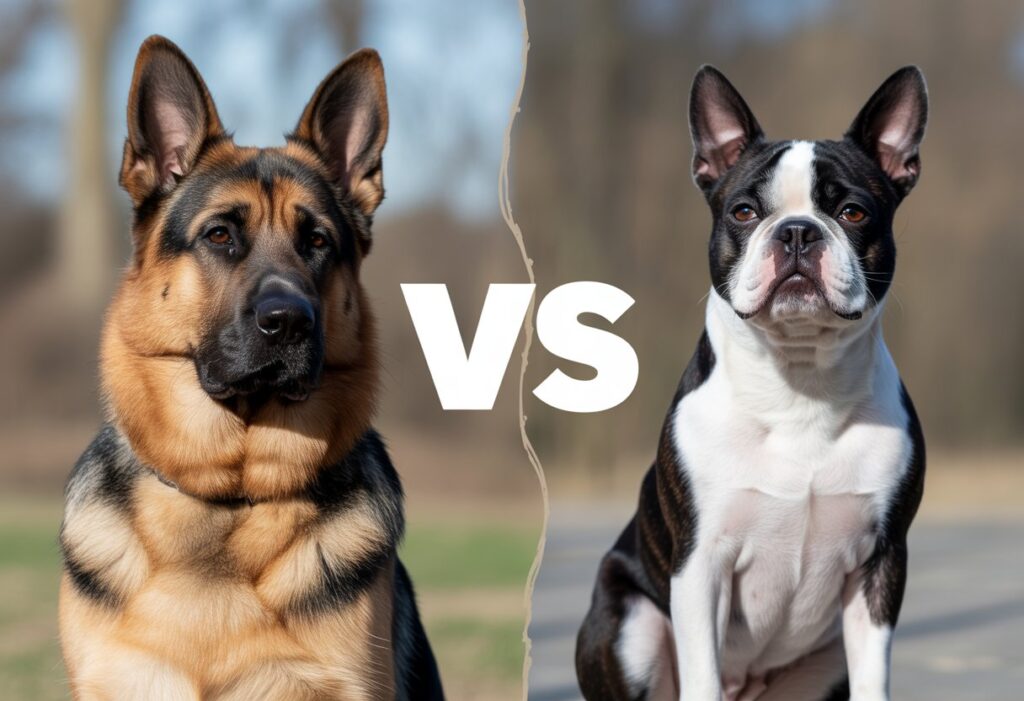Choosing between a German Shepherd and a Cavalier King Charles Spaniel isn’t easy, especially when both breeds bring so much to the table. German Shepherds stand out for their strength, intelligence, and loyalty. Cavaliers, on the other hand, win hearts with their gentle, friendly personalities.
Your lifestyle, living space, and energy level matter a lot when picking the right dog. There’s no single “best” breed—it’s all about what fits you.
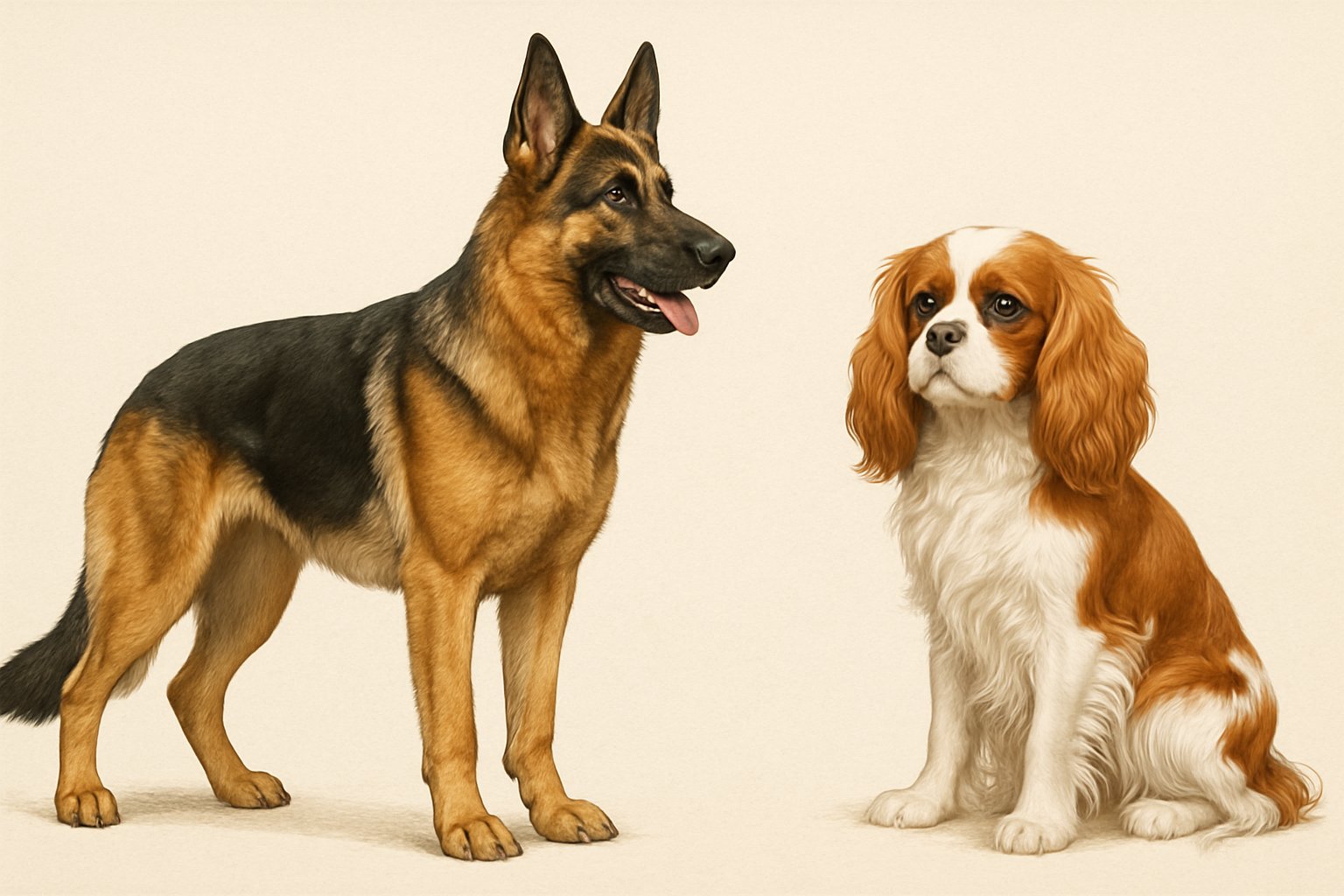
German Shepherds are bigger and need more activity. Cavaliers are smaller and generally get by with less exercise.
Each breed has its own care needs, health quirks, and lovable qualities. Let’s break down what makes each one tick.
Key Takeaways
- German Shepherds and Cavaliers differ a lot in size, energy, and looks.
- Their personalities and care needs aren’t the same.
- The “right” dog depends on your day-to-day life and what you want in a companion.
Origins and History
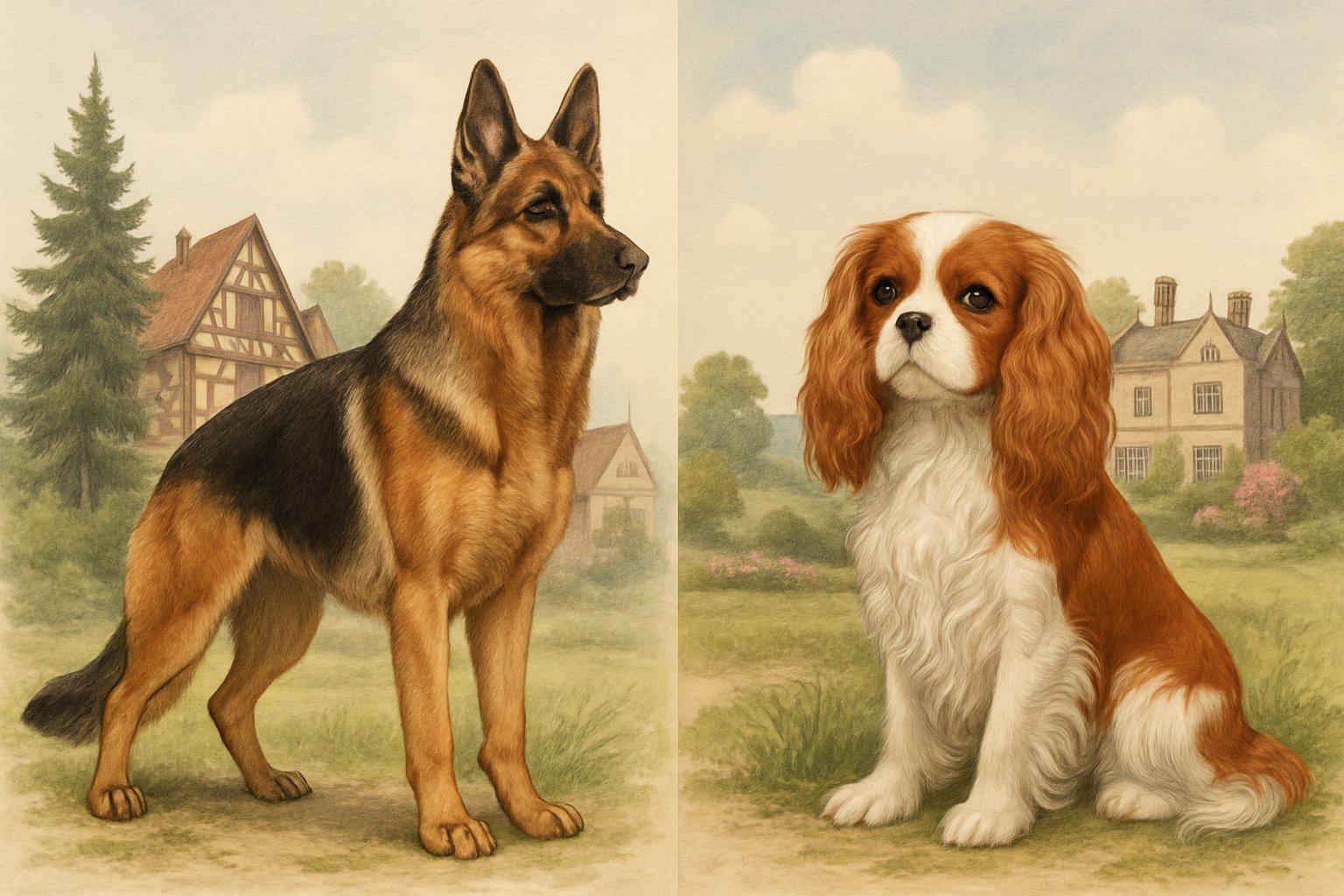
German Shepherds and Cavalier King Charles Spaniels both come from purebred lines, but their pasts couldn’t be more different. One breed was made for work, the other for company and comfort.
German Shepherd Heritage
German Shepherds got their start in Germany in the late 1800s. Captain Max von Stephanitz set out to create a versatile herding and working dog.
He picked dogs with strong working skills. By 1899, the Verein für Deutsche Schäferhunde (Society for the German Shepherd Dog) had formed.
German Shepherds were bred to be smart, loyal, and strong. That’s why they became favorites for police, military, and guide work.
Their working roots mean they’re active and pick things up quickly.
Cavalier King Charles Spaniel Background
The Cavalier King Charles Spaniel’s history is tied to English royalty. The breed’s name comes from King Charles II, who adored small spaniels.
You’ll spot these dogs in 16th and 17th-century paintings with nobles and kings. Spaniels like these were bred to be companion dogs for noble families.
They’re gentle, affectionate, and social. In the early 1900s, breeders worked to bring back the look from King Charles II’s era.
Now, Cavaliers are known for their sweet nature and classic style.
Evolution Among Dog Breeds
German Shepherds and Cavaliers really show how breeding shapes dogs for different jobs. Shepherds were made for tough tasks; Cavaliers for gentle companionship.
The breeds’ backgrounds influence how they act and what they need. Selective breeding can create dogs for just about any lifestyle or purpose, honestly.
Physical Characteristics and Appearance
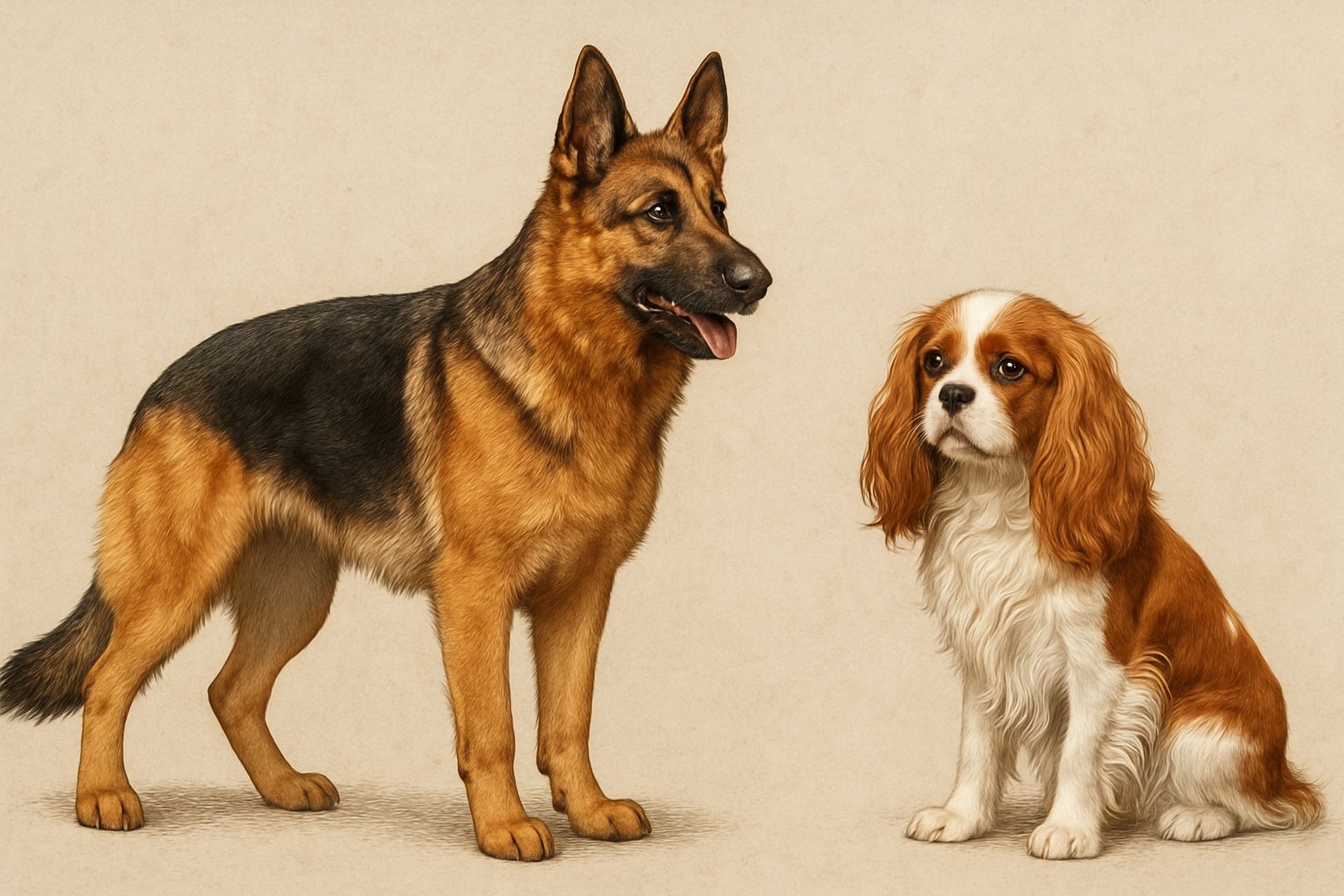
German Shepherds and Cavalier King Charles Spaniels look nothing alike. Their size, shape, coats, and faces all stand out—and those differences affect how you care for them.
Body Size and Structure
German Shepherds are big, strong dogs with a muscular build. Adults stand about 22–26 inches at the shoulder and weigh 50–90 pounds.
They’re longer than they are tall, which gives them a balanced, athletic look. Their backs slope gently from shoulders to hips.
Cavalier King Charles Spaniels are much smaller—just 12–13 inches tall and 13–18 pounds as adults. They have compact, level bodies and are light enough to carry around.
Here’s a side-by-side:
| Breed | Height | Weight | Build |
|---|---|---|---|
| German Shepherd | 22–26 inches | 50–90 pounds | Strong, long |
| Cavalier King Charles Spaniel | 12–13 inches | 13–18 pounds | Compact, light |
Coat Types and Colors
German Shepherds have a double coat: a dense, straight (sometimes wavy) outer layer and a soft undercoat for insulation. Most are black and tan, but you’ll see sable, solid black, and even white.
Cavaliers have long, silky fur—straight or a bit wavy. Their ears, tails, and legs have extra feathering. Common colors: Blenheim (chestnut/white), Tricolor (black/white/tan), Ruby (solid red), and Black & Tan.
Both breeds shed, but German Shepherds lose more fur year-round. Regular brushing helps keep the mess down and their coats healthy.
Distinctive Features
German Shepherds have a long muzzle, upright ears, and an alert, smart look. Their eyes are almond-shaped and dark, which gives them a serious vibe.
Their tails are bushy and hang low.
Cavaliers have a shorter, rounded nose—not flat, but definitely shorter than most. Their big, round, dark eyes sit wide apart and give them a soft, friendly face.
Their long, silky ears frame their face.
Breed features affect health, too. Shepherds’ sloped backs can lead to hip problems. Cavaliers’ head shape may cause eye or breathing issues. Regular check-ups are a must to catch problems early.
Temperament and Personality
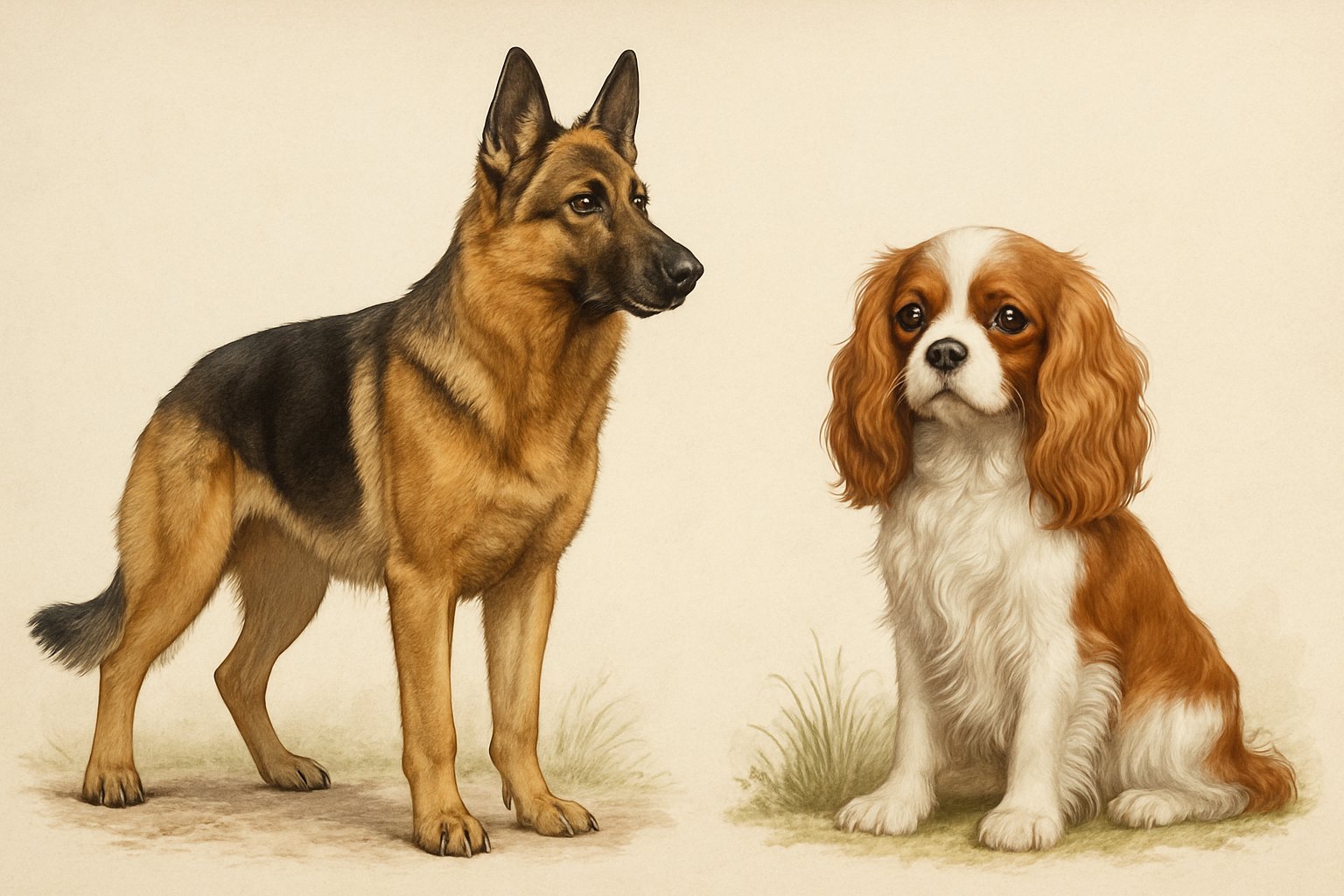
German Shepherds and Cavaliers are worlds apart in personality. How they act, learn, and get along with other pets all reflect their unique backgrounds.
Behavior With Families
German Shepherds are loyal and protective. They bond tightly with their people and can be gentle with kids, though they sometimes act wary around strangers.
Because they’re big and energetic, it’s smart to supervise them around young children.
Cavaliers are friendly and affectionate with almost everyone. They love being close to people and are great with families, whether you’ve got kids or grandparents at home.
Their small size makes them less intimidating and easier for children to handle.
If you’re looking for a gentle, easygoing lapdog, the Cavalier is a solid choice. If you want a dog that’s up for adventure and will watch over your crew, the German Shepherd’s your pick.
Trainability and Intelligence
German Shepherds are famously smart and pick up new things fast. That’s why they’re used as police and military dogs.
They thrive on training and love learning new commands, as long as you’re consistent.
Cavaliers are clever too, just not quite as focused. They’re eager to please and respond well to positive reinforcement.
They do well with basic training, but aren’t as suited for complex jobs as Shepherds or Collies.
German Shepherds need mental challenges to stay happy. Cavaliers mostly want to make you smile and enjoy simple tricks.
Compatibility With Other Pets
German Shepherds can act dominant or wary around other animals if they haven’t been socialized. Their guarding instincts run deep.
If you introduce them slowly and calmly to other pets, they can learn to relax in a multi-pet home.
Cavaliers usually get along great with other dogs and even cats. They’re naturally sociable and gentle, and less territorial.
If you want a dog that blends into a multi-pet family, the Cavalier is probably the easier route. German Shepherds just need more socialization and patience, but it can work.
Health and Lifespan
German Shepherds and Cavaliers face different health issues, genetic risks, and life expectancies. Knowing what you’re up against helps you keep your dog healthier, longer.
Common Health Issues
German Shepherds are prone to joint problems like hip and elbow dysplasia. These can cause pain and mobility issues.
They also risk bloat, a dangerous stomach condition.
Cavalier King Charles Spaniels often deal with heart disease, especially myxomatous mitral valve disease (MMVD). This can show up even in young dogs.
They’re also likely to get ear infections and sometimes eye problems.
It’s a good idea to get regular vet checkups and watch for signs like limping or coughing.
Genetic Conditions
German Shepherds are at risk for degenerative myelopathy, which affects the spinal cord and can cause weakness in the back legs as they age.
They also have higher risks for allergies and autoimmune problems, which can affect their skin and energy.
Cavaliers can inherit syringomyelia, a painful spinal disease, and have a strong genetic link to MMVD. Some also get luxating patella (loose kneecap).
Genetic testing is available for many of these issues. Responsible breeders screen their dogs to help reduce risks.
Expected Lifespan
German Shepherds typically live 9 to 13 years. Serious joint or neurological problems can shorten that.
Cavaliers often make it to 12 to 15 years. But heart disease, especially MMVD, can cut that short if it’s not managed.
Regular exercise, a balanced diet, and vet care go a long way toward a longer, healthier life. Catching health problems early really helps.
Exercise and Care Needs
German Shepherds need more exercise and regular grooming than Cavaliers. Each breed’s daily care routine can have a big impact on your schedule and lifestyle.
Activity Levels
German Shepherds are famous for their energy and sharp minds. They need at least 90 minutes of exercise each day.
You can mix in long walks, running, fetch, or some agility games. Puppies need softer play, broken up through the day.
Cavalier King Charles Spaniels are a bit more relaxed. Still, they need at least 30-60 minutes of activity.
Short walks and playful moments usually do the trick. Older dogs or females might want less, while some males have extra pep.
Key differences:
| Breed | Daily Exercise Need | Best Activities |
|---|---|---|
| German Shepherd Dog | 90+ mins | Running, hiking, training |
| Cavalier King Charles | 30-60 mins | Walks, games, fetch |
German Shepherds fit best with active owners. Cavaliers work well for folks who prefer a slower pace.
Grooming Requirements
German Shepherds have a double coat that sheds all year, but it really ramps up in spring and fall. You should brush your dog at least three times a week.
When shedding gets heavy, daily brushing helps keep fur under control. Bathing every few months is fine unless your dog gets really dirty outside.
Cavalier King Charles Spaniels have long, silky fur that tangles easily. Try to brush them 3-4 times a week to keep their coats smooth.
Watch for knots behind the ears and legs. All ages and sexes need regular grooming, but puppies might need extra patience as they learn.
Nail trimming, ear cleaning, and dental care matter for both breeds. These steps help your dog stay healthy and look good.
Comparisons With Other Popular Breeds
German Shepherds often get compared to other working breeds for their size and personality. Cavaliers are closer to other small companion dogs in how they act and what they need.
German Shepherd vs Labrador Retriever
German Shepherds and Labradors are both smart, active, and friendly. German Shepherds lean more protective, so they’re popular for police and guard jobs.
Labradors? They’re usually more social and gentle, especially with kids.
Key Differences:
- Shedding: Both shed, but German Shepherds might need more brushing.
- Exercise: Both want daily activity, but Labradors tend to be more playful and less focused on guarding.
- Training: German Shepherds sometimes act stubborn if you’re not firm. Labradors usually just want to please you.
Labradors seem like a good fit for outgoing families who want a patient dog. German Shepherds make sense if you’re after loyalty and don’t mind putting in the training.
Cavalier vs Cocker Spaniel
Cavalier King Charles Spaniels and Cocker Spaniels both have those long ears and sweet personalities. Cavaliers are smaller, about 13-18 pounds, while Cockers weigh 20-30 pounds.
- Temperament: Cavaliers are gentle and usually calm. Cocker Spaniels bring more energy and playfulness.
- Care Needs: Both need regular brushing. Cockers often need more ear care and extra grooming.
- Health: Cavaliers can have heart problems. Cockers get ear infections more often.
If you want a quiet lap dog, a Cavalier might be your pick. If you’re up for more play and don’t mind the extra grooming, maybe go for a Cocker Spaniel.
Relative to Small and Large Breeds
German Shepherds stand out as one of the larger breeds, right up there with Rottweilers, Golden Retrievers, and Boxers. They need plenty of space and a good amount of exercise.
Small breeds, like the Cavalier, Pug, or Yorkshire Terrier, work well in apartments. They’re much easier to travel with too.
Size and Energy Comparison Table:
| Breed | Size | Typical Energy Level | Exercise Needs |
|---|---|---|---|
| German Shepherd | Large | High | 1-2 hrs/day |
| Labrador Retriever | Large | High | 1-2 hrs/day |
| Cavalier King Charles | Small | Medium | 30 mins/day |
| Pug | Small | Low-Medium | 20 mins/day |
| Golden Retriever | Large | High | 1-2 hrs/day |
| Shih Tzu | Small | Low | 15-30 mins/day |
Tiny dogs like Chihuahuas, Maltese, and Bichon Frise are usually easier to groom and carry around. On the other hand, big breeds like Great Danes and Saint Bernards take up even more space than a German Shepherd does.
If you’re worried about size, exercise, or grooming, these differences definitely come into play. It makes you think twice before picking a breed, doesn’t it?

